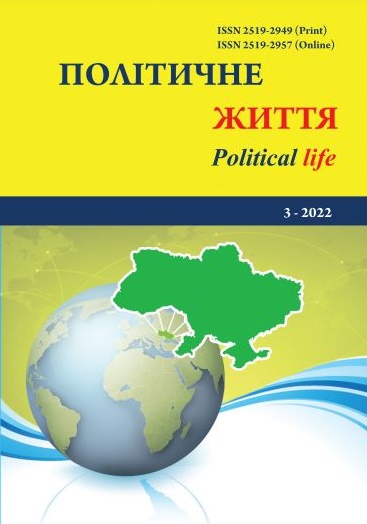Algorithm of neurolinguistic manipulation in political forecasting on the example of the Milton’s model
DOI:
https://doi.org/10.31558/2519-2949.2022.3.12Keywords:
neurolinguistic programming; Milton model; political advertising; discourse analysis; linguistic manipulationAbstract
The scientific article investigates techniques and models of neurolinguistic programming. Particular attention is paid to the Milton’s popular metamodel, which is often used in politics. The manipulative nature of modern NLP expert techniques during election campaigns increasingly indicates the use of metamodels in politics. The relevance of the research topic is due to the great need to study the manipulative technologies used during election races, in particular the linguistic system of manipulation. The aim of the research is to study the basic techniques of neurolinguistic programming used in politics. Objectives: to analyze the linguistic elements of Milton’s metamodel on specific examples; to find out the theoretical basis and the basis of the metamodel; explore the strategies and stages of Milton’s model. Research methods: a set of methods is used in the work, namely: synthesis and analysis in clarifying the basic terminology used in the field of neurolinguistic programming; comparative analysis in the study of NLP models; discourse analysis in the application of Milton’s model on specific examples. To achieve the goals in the work, discourse analysis is chosen as the main research method. Additionally, general scientific and special scientific methods, classification and grouping, system-structural, hermeneutic, prognostic were used. Research has attempted to investigate, analyze, and structure neurolinguistic programming techniques, namely Milton’s models. This paper substantiates the theoretical and practical foundations of NLP technologies on the example of use in politics. The practical significance of the obtained results of the work is that they can be used in research for further research on this topic, as well as used for NLP analysis for other political campaigns. The study presents the main suggestion strategies used in Milton’s model, as well as analyzed linguistic techniques. Techniques and techniques of linguistic manipulations are considered on concrete examples (speeches, slogans of politicians and political campaigns). The psychological features of Milton’s model and inverse metamodel are indicated. The main stages of inversion and patterns of indirect detection are studied. The article is devoted to the algorithm of linguistic manipulation in politics on the example of Milton’s model. The concept of Milton’s inverse metamodel, its advantages and place in the political sphere are revealed, the material on the main subsets of information of Milton’s model and their subcategories is presented.
References
Neuro Linguistic Programming: Mind Tools Co., Ltd. [online]. Available at: https://www.mindtools.co.th/.
Карамишева, Н. В. Модальна логіка. [online]. Available at: https://textbook.com.ua/logika/1473448800/s-21.
Ковалевська, А. В. Метамодель лінгвістичної сугестивності політичних рекламних слоганів: автореф. дис. на здобуття наук. ступеня канд. філ. наук : спец. 10.02.01 «українська мова». Одеса. 2011. С. 8.
Ковалевська, Т. Ю. Комунікативні аспекти нейролінгвістичного програмування: монографія. Одеса. 2011. С. 10.
Кутуза, Н. В. Гіпноіндуктори впливової формули позитивації у комерційному рекламному дискурсі: Записки з українського мовознавства. 2019. Вип. 26 (2). С. 234.
Модель языка или метамодель НЛП. 4BRAIN. [online]. Available at: https://4brain.ru/nlp/model-jazyka.php.
Шульц, В. Л. Информационные войны. Научно-практический междисциплинарный журнал. Москва. 2013. С. 13.

